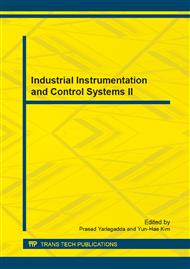[1]
A. K. Varkani, H. Monsef and H. R. Baghaee, Strategy for Participation of Wind Power in Power Market Considering the Uncertainty in Production, International review of electrical engineering-IREE, vol. 4, n. 5, Sep-Oct 2009, pp.1005-1014.
Google Scholar
[2]
P. Kundur, Power System Stability and Control (New York: McGraw-Hill, 1994).
Google Scholar
[3]
R. Pena, J. C. Clare and G. M. Asher, Doubly fed induction generator using back-to-back PWM converters and its applications to variable-speed wind-energy generation, IEE Proceedings: Electric Power Application, vol. 143, n. 3, May 1996, pp.231-241.
DOI: 10.1049/ip-epa:19960288
Google Scholar
[4]
M. Akbari and S. M. Madani, Improving Contribution of DFIG-Based Wind Farms in Short-Term Frequency Regulation of Power Systems, International review of electrical engineering-IREE, vol. 5, n. 4, Jul-Aug 2010, pp.1670-1677.
DOI: 10.1109/iraniancee.2010.5506955
Google Scholar
[5]
H. Brahmi and R. Dhifaoui, The Unified Power Flow Controller: a Possible Solution to Support Wind Energy Penetration in the Power System, International review of electrical engineering-IREE, vol. 3, n. 6, Nov-Dec 2010, pp.1015-1023.
Google Scholar
[6]
J. Morren, S. W. H. Haan, W. L. Kling, et al, Wind turbines emulating inertia and supporting primary frequency control, IEEE Transaction on Power Systems, vol. 21 n. 1, Feb. 2006, pp.433-434.
DOI: 10.1109/tpwrs.2005.861956
Google Scholar
[7]
Jun Cao, Hongfu Wang and Jiaju Qiu, Frequency control strategy of variable-speed constant-frequency doubly-fed induction generator wind turbines, Automation of Electric Power Systems, vol. 33 no.13, 2009, pp.78-82.
DOI: 10.1109/3ca.2010.5533875
Google Scholar
[8]
P. K. Keung, P. Li, H. Banakar, et al, Kinetic Energy of Wind Turbine Generators for System Frequency Support, IEEE Transaction on Power Systems, vol. 24, n. 1, Feb 2009, pp.279-287.
DOI: 10.1109/tpwrs.2008.2004827
Google Scholar
[9]
J. M. Mauricio, A. Marano, E. A. Gomez, et al, Frequency regulation contribution through variable-speed wind energy conversion systems, IEEE Transaction on Power Systems, vol. 24, n. 1, Feb 2009, pp.173-180.
DOI: 10.1109/tpwrs.2008.2009398
Google Scholar
[10]
L. Holdsworth, J. B. Ekanayake, and N. Jenkins, Power system frequency response from fixed speed and doubly fed induction generator-based wind turbines, Wind Energy, vol. 7, n. 1, Jan-Feb 2004, pp.21-35.
DOI: 10.1002/we.105
Google Scholar
[11]
A. J. L. Rodriguez, S. Arnalte, and J. C. Burgos, Automatic generation control of a wind farm with variable speed wind turbines, IEEE Transaction on Energy Conversion, vol. 17, n. 2, Jun 2002, pp.279-284.
DOI: 10.1109/tec.2002.1009481
Google Scholar
[12]
J. Conroy and R. Watson, Frequency response capability of full converter wind turbine generators in comparison to conventional generation, IEEE Transaction on Power Systems, vol. 23, n. 2, May 2008, pp.649-656.
DOI: 10.1109/tpwrs.2008.920197
Google Scholar
[13]
L. Ren, C. Chien, C. M. Hung, et al, Dynamic Reserve Allocation for System Contingency by DFIG Wind Farms, IEEE Transaction on Power Systems, vol. 23, n. 2, May 2008, pp.729-736.
DOI: 10.1109/tpwrs.2008.920071
Google Scholar
[14]
N. R. Ullah, T. Thiringer and D. Karlsson, Temporary Primary Frequency Control Support by Variable Speed Wind Turbines -Potential and Applications, IEEE Transaction on Power Systems, vol. 23, n. 2, May 2008, pp.601-612.
DOI: 10.1109/tpwrs.2008.920076
Google Scholar
[15]
R.G. Almeida and L.J.A. Pecas, Participation of Doubly Fed Induction Wind Generators in System Frequency Regulation, IEEE Transaction on Power Systems, vol. 22, n. 3, Aug 2007, pp.944-950.
DOI: 10.1109/tpwrs.2007.901096
Google Scholar
[16]
P. Bousseau, R. Belhomme, E. Monnot, et al, Contribution of wind farms to ancillary services. Proc. CIGRE 2006 Plenary Session, Paris, France, Sep 2006.
Google Scholar
[17]
A. Yazdani and R. Iravani, A neutral-point clamped converter system for direct-drive variable-speed wind power unit, IEEE Transaction on Energy Conversion, vol. 21, n. 2, Jun 2006, pp.596-607.
DOI: 10.1109/tec.2005.860392
Google Scholar
[18]
R. G. Almeida, E. D. Castronuovo and L. J. A. Pecas, Optimum Generation Control in Wind Parks When Carrying Out System Operator Requests, IEEE Transaction on Power Systems, vol. 21, n. 2, May 2006, pp.718-725.
DOI: 10.1109/tpwrs.2005.861996
Google Scholar
[19]
M. E. Mokadem, V. Courtecuisse, C. Saudemont, et al, Fuzzy Logic Supervisor-Based Primary Frequency Control Experiments of a Variable-Speed Wind Generator, IEEE Transaction on Power Systems, vol. 24, n. 1, Feb 2009, pp.407-417.
DOI: 10.1109/tpwrs.2008.2007005
Google Scholar
[20]
L. N. Xu, Neural network control; Electronics Industry Publishing House: Beijing, China, 2009.
Google Scholar
[21]
J. J. Hopfield, Neural networks and physical systems with emergent collective computational abilities. Proceedings of the National Academy of Sciences of the USA. 1982, 79, 2554–2558.
DOI: 10.1073/pnas.79.8.2554
Google Scholar
[22]
J. E. Steck and S. N. Balakrishnan, Use of Hopfield Neural Networks in Optimal Guidance, IEEE Transactions on Aerospace and Electronic Systems, vol. 30, n. 1, Jan 1994, pp.887-293.
DOI: 10.1109/7.250431
Google Scholar
[23]
J. K. Liu, MATLAB simulation of advanced PID control (Beijing: Publishing House of Electronics Industry, 2003).
Google Scholar
[24]
M. Karam and M. S. Fadali, System identification using a Fourier-Hopfield neural network, Proceedings of the 44th IEEE 2001 Midwest Symposium on Circuits and Systems, vol. 30, n. 1, 2001, pp.641-644.
DOI: 10.1109/mwscas.2001.986271
Google Scholar
[25]
C. Q. Zhang and M. S. Fadali, Nonlinear system identification using a Gabor/Hopfield network, IEEE Transactions on Systems, vol. 26, n. 1, Feb 1996, pp.124-134.
DOI: 10.1109/3477.484444
Google Scholar


